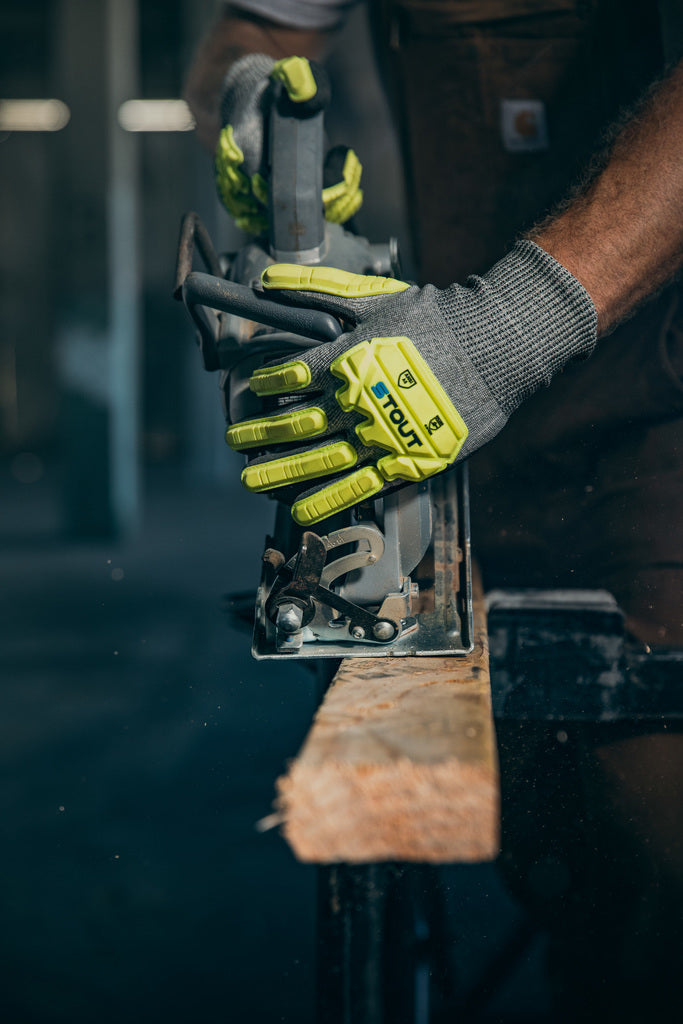What if you could work faster without cutting corners on your safety? At Stout Gloves, we stand by our commitment to keep you safe in the toughest jobs without compromising your dexterity and comfort. Our design team works to meet and exceed ANSI and EN388 safety standards while pioneering more flexible, durable fabrics, leathers, and TPR. We understand that some of the most demanding jobs require a cut resistance standard that is up to the task. No glove is completely cut-proof, so it’s important to understand your protection options to prevent injury.
Unsure which cut resistance level is right for you? We’ve got you covered.
What is the Cut Resistance Standard?
There are two major testing and classification standards used to measure cut resistance: The American ANSI/ISEA 105 standard and the European EN388 standard.
ANSI/ISEA 105-2016 standards are created through performance tests related to mechanical protection for abrasion, cut, puncture, and needlestick. ANSI/ISEA has a separate standard for impact testing: ANSI/ISEA 138.
In contrast, EN388 encompasses performance tests on impact, abrasion, cut, and tear.
Read more to understand how our gloves are tested and evaluated and which is the best for your occupation.
ANSI/ISEA 105 American National Standard:
The ANSI/ISEA 105 standard uses a test method called ASTM F2992-15 and evaluates cut resistance on a 9-level scale.
How are the ANSI/ISEA 105 Standard tests done?
Using a tomodynamometer (TDM-100) machine (shown above), a small rectangular sample of our glove materials are tested under three varied weights (i.e. 200, 400, 600) to achieve five cut-through distances (5-20 mm; 20-33 mm; and 33-50 mm) within each set of distance ranges. All cuts are made in the same direction, and the blade is replaced for each cut. Weight is added until cut is achieved. Five cuts are performed at each load on each glove sample for a total of 15 cuts per sample. The results are then used to determine the amount of weight required to cut through the glove material with 20mm blade travel.
This test procedure is repeated a total of three times, and the average of the three tests gives the final gram rating that ranges from 200 grams to 6000 grams of cut resistance.
What markings are used for ANSI/ISEA 105 Standards?
Though manufacturers are not required to label cut scores, ANSI/ISEA 105 cut-resistant gloves will be marked on the label or glove branding with their TDM-100 score, referenced as A1-A9.


The EN388 Standard evaluates and administers two cut levels through two different methods: The Coup Test and the ISO 13977 method (aka the TDM-100 Test). The latter test closely relates to the ANSI/ISEA 105 standard test.
How are the EN388 tests done?
During The Coup Test, samples of our gloves are cut with a counter-rotating circular blade that moves back and forth at 500 grams of load until cut is achieved. The performance is evaluated on a 1-5 scale based on the ratio of rotations needed to cut through the sample over a separate control sample.
If no cut is achieved after 60 rotations, the ISO 13977 method (TDM-100 Test) is administered. For this method, a straight razor blade is administered to a sample of the glove at variable weight increments. Although this is similar to what is done for the ANSI/ISEA 105 standards, there are different requirements for EN388 standards.
Like the ANSI/ISEA 105 standard test, the blade is changed and weight added after each cut is made. Results are measured in Newtons, ranging from 2-30 Newtons. It is generally believed that this method provides more consistent results than The Coup Test and does a better job of delivering consistent results through a method that more realistically simulates actual workplace cut hazards.
What markings are used for EN388 standards?
Our EN 388 cut-resistant gloves are marked with one score, depending on the cut-resistance level. The Coup Test score is referenced as level 1-5, and the TDM-100 score is referenced as level A-F.
Still unsure which glove is best for you?
At Stout Gloves, we’re committed to making sure you have everything you need for the task at hand. Our customer service and sales team is here to help you find the best fit and protection level for your trade and occupation, and we welcome your questions! We believe that confidence and safety go hand-in-hand for job performance, and we’ve enabled thousands of people like you stay safe and excel.
Contact us at sales@stoutgloves.com or toll-free at 1.877.558.5547 to discuss your specific needs with one of the expert members of our team. We look forward to meeting you!











